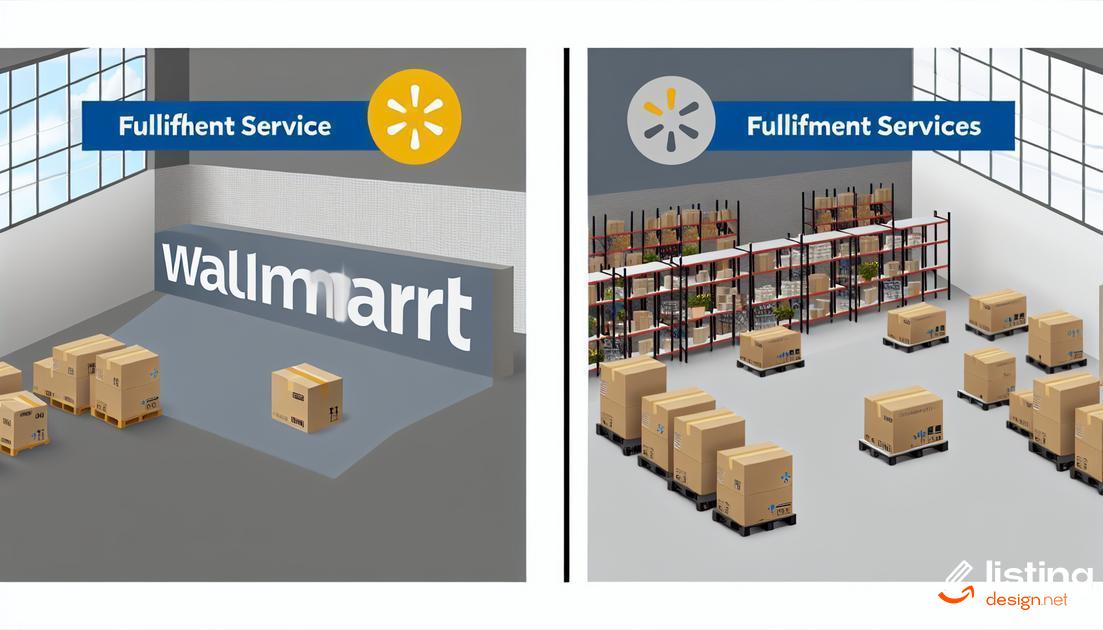In the competitive world of e-commerce, choosing the right fulfillment service is crucial for success. This post provides an in-depth Walmart WFS vs. Amazon FBA comparison, highlighting key differences, costs, and benefits of each platform. Understanding these differences can help you make an informed decision that best suits your business needs. Let’s dive into the details and explore how Walmart WFS and Amazon FBA stack up against each other.
Table of Contents
Introduction to Walmart WFS and Amazon FBA
Both Walmart WFS (Walmart Fulfillment Services) and Amazon FBA (Fulfillment by Amazon) offer sellers an efficient way to handle storage, shipping, and customer service. Each platform has its unique advantages, and understanding them is key to deciding which service best meets your needs. Walmart WFS is designed to leverage Walmart’s extensive network of distribution centers, providing two-day shipping to a significant portion of the U.S. Additionally, sellers benefit from Walmart’s brand trust and significant customer base.
Amazon FBA offers a well-established fulfillment network renowned for its fast delivery services, including Prime shipping options. Sellers using FBA can take advantage of Amazon’s algorithm, often seeing improved product rankings and visibility. Amazon’s customer service is another critical draw, as FBA handles returns and customer inquiries efficiently.
Costs and Fees Breakdown

Understanding Cost Structures
When comparing Walmart WFS and Amazon FBA, it is crucial to understand the cost structures of each service.
Walmart WFS Fees:
- Fulfillment Fee: Charged per unit based on weight and dimensions.
- Storage Fee: Calculated monthly, based on cubic feet used.
- Inbound Shipping: Costs vary depending on your carrier choice.
Amazon FBA Fees:
- Fulfillment Fee: Also per unit, influenced by size and weight.
- Storage Fee: Charged monthly, varying with seasonality; higher in Q4.
- Long-Term Storage Fee: Additional fee if inventory stays over 365 days.
For cost effectiveness, consider product types and sales volume. Walmart WFS might offer savings with lower storage fees, while Amazon FBA can be more expensive due to additional charges like long-term storage fees.
Inventory Management and Storage
Effective inventory management and storage are critical for any e-commerce business. Both Walmart’s WFS and Amazon’s FBA provide robust solutions to help sellers manage their stock. Amazon FBA allows sellers to store products in Amazon’s vast network of warehouses, leveraging advanced technology such as AI-based inventory tracking to ensure optimal stock levels.
Similarly, Walmart WFS offers extensive warehouse space and efficient inventory management tools. Sellers can benefit from Walmart’s sophisticated logistics network, which guarantees that stock is continuously monitored and replenished as needed. Both platforms provide analytics and reports that help sellers make data-driven decisions about their inventory.
Storage costs are an important consideration. Amazon FBA charges based on the storage space used and the duration for which the inventory is held, increasing fees during peak seasons. Walmart WFS offers competitive storage pricing, with clear guidelines to help sellers optimize their storage costs.
In terms of handling returns, both Walmart and Amazon offer efficient processes to manage returned items, though there are differences in how each manages restocking fees and damaged goods. Sellers should carefully evaluate these differences to choose the best fit for their business needs.
Shipping and Delivery Speed

When comparing Walmart WFS and Amazon FBA, shipping and delivery speed are vital factors. Both platforms have robust fulfillment networks, but there are noticeable differences. Amazon FBA is renowned for its Prime service, which offers two-day shipping to millions of Prime members. This feature can significantly boost your sales, as customers often prioritize quicker delivery times.
On the other hand, Walmart WFS also promises competitive delivery times and offers a two-day shipping option for many products, albeit to a smaller customer base compared to Amazon Prime. Walmart’s partnership with various carriers can result in reliable delivery speed, but its reach may not be as extensive.
Both services aim to minimize delivery times to enhance customer satisfaction. However, Amazon’s extensive logistics network often gives it a slight edge in terms of consistent delivery speed and reach. Walmart is continuously expanding its capabilities, but currently, Amazon holds a marginal lead in this aspect.
Ultimately, your choice may depend on your target audience and which platform aligns more closely with your logistics needs. Both offer competitive shipping solutions, aiming to dish out faster delivery times to keep customers happy.
Customer Service and Returns
When evaluating Customer Service and Returns for Walmart WFS and Amazon FBA, it is essential to consider the level of service provided by each platform. With Amazon FBA, sellers benefit from Amazon’s extensive customer service network, which includes handling returns and managing customer inquiries 24/7. This robust system ensures that customers receive prompt assistance, leading to higher satisfaction rates.
In contrast, Walmart WFS offers a more streamlined approach. Walmart’s customer service team is available to handle returns and customer issues, but the scope and reach may not be as wide-ranging as Amazon’s. However, Walmart’s focus on providing quality service ensures that customers receive the support they need, albeit in a less extensive network.
Returns processing is another critical aspect. Amazon FBA’s return process is highly automated, allowing for quick and efficient handling of returns. This automation reduces the burden on sellers and enhances overall customer satisfaction. On the other hand, Walmart WFS’s returns process, while effective, might require more involvement from the seller, which can be time-consuming.
Customer feedback and claims can also impact the seller’s experience. Amazon FBA’s system is designed to minimize negative feedback and manage claims efficiently, protecting the seller’s reputation. Walmart WFS, while also attentive to customer feedback, may offer a different level of protection and responsiveness when compared to Amazon FBA.
Seller Support and Tools

Comprehensive Seller Tools
Both Walmart WFS and Amazon FBA offer a robust suite of tools designed to assist sellers in managing their businesses effectively. These tools range from inventory management systems to advanced analytics and reporting features. For example, Walmart’s Seller Center provides insights on sales performance, inventory levels, and other critical metrics to help sellers make informed decisions.
Dedicated Seller Support
When it comes to seller support, both platforms offer dedicated resources. Amazon’s Seller Central offers 24/7 support through various channels, including live chat, email, and phone. This can be particularly useful for resolving issues quickly and efficiently. On the other hand, Walmart provides a dedicated support team within their Seller Center, which includes comprehensive documentation and a well-structured FAQ section.
Training and Educational Resources
Amazon FBA provides extensive training materials, including webinars, tutorials, and seller forums where users can exchange tips and advice. Walmart WFS also offers educational resources, including video tutorials and a knowledge base that caters to both new and experienced sellers. These resources are crucial for understanding platform-specific requirements and maximizing sales potential.
Third-Party Integration
Both Walmart WFS and Amazon FBA support third-party software integrations. These integrations can help automate various aspects of your business, from order fulfillment to customer communication. Amazon’s marketplace has a wider range of third-party applications, thanks to its larger ecosystem. However, Walmart is rapidly catching up, continuously expanding its partner network to offer more integrations.
Advantages of Walmart WFS
Utilizing the Walmart Marketplace
The Walmart Fulfillment Services (WFS) provide sellers with an opportunity to leverage one of the world’s largest retailers. By using WFS, sellers can benefit from Walmart’s extensive customer base and trusted brand reputation.
Cost-Effective Fulfillment
WFS offers competitive pricing on fulfillment services. With transparent pricing and fewer unexpected fees, sellers can manage their expenses more effectively. This affordability can help small and medium-sized businesses thrive.
Fast and Reliable Shipping
Walmart’s vast network of distribution centers ensures fast and reliable shipping. Customers often enjoy two-day delivery on many items, enhancing the shopping experience and increasing customer satisfaction.
Comprehensive Support
WFS provides sellers with robust support, including assistance with inventory management, shipping, and returns. The support team is dedicated to helping sellers succeed, offering valuable resources and guidance.
Enhanced Customer Trust
Products fulfilled by Walmart are eligible for Walmart’s free and easy returns policy, building greater trust among customers. This can lead to higher conversion rates and repeat purchases.
Proximity to Customers
With numerous fulfillment centers strategically located across the U.S., WFS ensures that products are stored closer to customers. This proximity reduces shipping times and costs, leading to a better overall shopping experience.
Advantages of Amazon FBA

Amazon FBA’s widespread recognition stems from its robust logistics network and efficiency in fulfillment. Sellers benefit from Amazon’s advanced warehousing, allowing for fast and reliable shipping due to its extensive infrastructure.
This service offers a compelling customer experience by ensuring quick delivery and seamless returns. The trust customers place in Amazon translates to increased sales and heightened visibility within Amazon’s marketplace.
Amazon FBA supports multi-channel fulfillment, providing flexibility to sellers who operate on various platforms. Its comprehensive inventory management system streamlines stock handling, minimizing disruptions and ensuring availability.
With Amazon’s global reach, FBA enables sellers to tap into international markets, scaling their business efficiently without the complexities of cross-border logistics. Additionally, FBA integrates with Amazon Prime, granting sellers access to a vast pool of loyal Prime shoppers.
This service also comes with extensive seller tools, such as reporting and analytics tools, which empower sellers to make data-driven decisions to boost performance and sales. The robust customer service infrastructure ensures that any issues arising are swiftly addressed, enhancing the overall shopping experience.


